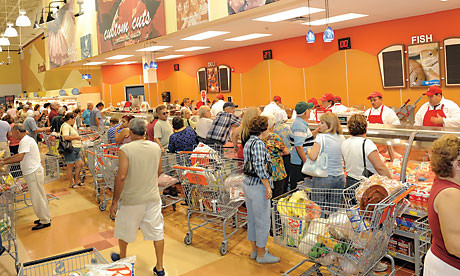SHARE:
supermarkets
Sedano's New Generation
The nation's largest Hispanic retailer is trying to win over younger Cuban-Americans and capture new arrivals from the Americas and Caribbean.
 Sedano’s supermarket shoppers [Photo: Alex Gort Jr.] |
The new store’s market area, where Javier Herrán happens to live, says something about the changing demographics Sedano’s faces. The largest demographic group in the market area is still Cuban, but the second- and third-largest are Colombian and Venezuelan. Then, while the store is on Southwest 8th Street, it is so far in the western suburbs — far from the heart of Little Havana on Calle Ocho — that the Herráns expect to see Hispanic shoppers coming across from Naples.
| “A company like Sedano’s is benefiting today because they are tailoring their assortment, service and atmosphere all to uniquely fit and make the Hispanic consumer more comfortable.” — consultant Bill Bishop |
What shoppers will find in the 37,000-sq.-ft. prototype are many of the innovations that all supermarkets are using to try to lure customers. Case in point: A large prepared foods section, “the light at the end of the tunnel for a lot of these chains,” says Wade Hanson, senior manager with Chicago-based food industry consultant Technomic. Prepared food sales, which carry fatter margins than groceries, are growing twice as fast as restaurant sales, he says, and are allowing supermarkets to recapture consumer spending lost to eateries.
Shoppers also will find 18 of 66 freezer cases stocked with familiar foods from their place of origin or homes — the yucca fries, frozen green banana dough, pigeon peas and other items on which Sedano’s should be able to capitalize. Bigger supermarket chains often miss nuances of product quality, quantity or pricing in such segments, says consultant Bill Bishop of Willard Bishop in Barrington, Ill. “A company like Sedano’s is benefiting today because they are tailoring their assortment, service and atmosphere all to uniquely fit and make the Hispanic consumer more comfortable,” Bishop says.
Indeed, you can tell a south Florida neighborhood’s demographics by the local Sedano’s product mix — lots of Caribbean island specialties in North Lauderdale, 32 feet of shelf space for Mexican items in Homestead.
The Herráns seem confident in their ability to reach consumers in the changing market. Same-store sales are up 6%, Jose Herrán Jr. says.
“I always say you can’t be something you’re not,” he says. “We’re Hispanic. We know what the consumers are looking for.”
Miami-Dade Makeup
Miami-Fort Lauderdale led the nation’s 20 largest metros in the percentage of population that speaks Spanish at home, 38%. Sixty-two percent of Miami-Dade’s 2.4 million residents are Hispanic. Among the 2.4 million residents:
33% are Cuban
23% are Hispanics from other countries
4% are Puerto Rican
2% are Mexican
Source: U.S. Census























